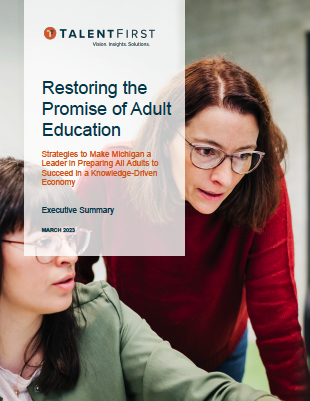Michigan faces two significant challenges to its economic success.
One is demographic: An aging population is retiring, while birth rates and in-migration are failing to replenish the talent pool. The other is that Michiganders have less education and skills compared to neighboring states and the nation overall. Central to that concern: Far too many adults lack a high school diploma.
This is holding us back and harming our residents. If Michigan hopes to compete in the knowledge-based economy, it must maximize the education and skills of its workforce. This includes optimizing an adult education system that currently meets less than 4% of the need while hundreds of thousands are sidelined from the workforce.
Current state: Coming up short
Michigan is making significant investments in post-secondary training and education. But those initiatives – and the good-paying jobs they make possible – remain out of reach for those who lack a high school diploma, as 716,000 did in 20191. Yet, even as Michigan’s adult education system serves just a fraction of the need, only 1 in 2 enrolled earn a high school diploma or GED. Adult learners are a diverse group and face a wide range of challenges with little support, resulting in unacceptable disparities in completion rates:
1 U.S. Census Bureau. 2019 American Community Survey 1-Year Survey.
2 Calculated by TalentFirst staff based on the Section 107 funding divided by the higher education budget appropriation as reported by the Senate Fiscal Agency, https://www.senate.michigan.gov/sfa/Departments/HighlightSheet/HIhed_web.pdf.
- If displaced homemaker, 1 in 4 chance of success
- With transportation barriers, 1 in 5 chance of success
- With transportation barriers and English language learners, 1 in 6 chance of success
- If Black/African American, 1 in 3 chance of success.
Meanwhile, state funding for adult education has plummeted for decades, and Michigan now invests 1 cent on adult basic education for every $1.00 spent on higher education.
In a state that produces only three graduates for every 10 job openings requiring a postsecondary credential, we must do better with this neglected component of talent development. Adult education can open the door to post-secondary programs, while also serving those who require basic education, English language acquisition, remediation, and high school completion/equivalency.
Our vision for improvement
The research-based strategies in this report aim to better align the adult education system, provide it with visibility and respect, expand capacity, and improve consistency, equity and learner persistence and success.
Our five-year objectives:
- Grow enrollment from serving 3.6% of the need to 10%.
- Improve completion rates from 39.9% to 80%.
- Eliminate the gap in outcomes for people of color and English language learners.
Building a best-in-class system for Michigan
Elevating adult education at the state level while retaining and bolstering the regional partnerships necessary to deploy resources locally will require collaboration among all who are affected by and have a role in adult education — including state government, education providers, workforce development organizations, employers, community partners, and other advocates. Strong state and regional leadership will be necessary to facilitate change.
Based on our review of the literature, stakeholder input, and examination of high-quality adult education systems across the nation, a best-in-class system should contain the following characteristics.
1. Governance
The state-level agency is connected administratively and/or by way of Memoranda of Understanding (MOUs) with other relevant agencies to work toward more effective integration at state, regional, and local levels. Public-private partnerships at the regional level govern provider procurement and oversight through well-defined partner MOUs. A dedicated statewide task force of adult educators, workforce development professionals, business, and advocates advises the state agency and helps to monitor progress on performance, equity, employer engagement, and other system improvements. Regions also consult their existing community engagement advisory committee or other state-approved advisory committee.
2. Funding
The state braids federal and state funding and distributes funds to regional partnerships that meet performance criteria. The state agency ensures statewide coverage of service based on population need and equitable access to services.
3. Delivery
Local providers are contracted by regional partnerships. State-level agency ensures availability of relevant and sufficient professional development and educator certification. Regional professional development also occurs as needed to address localized needs.
4. Performance Management
The state sets performance metrics with input from the state-level task force and holds regions accountable for performance. Providers are held accountable to these metrics via the regional partnerships, with regional reporting to the state level. State-provided technical assistance supports provider improvement and partner alignment/integration.
5. Communication
Two-way state-local communication channels keep information flows open and effective. State-regional joint marketing occurs to potential learners.
6. Learner Supports
The state requires regional partnerships (as part of funding) to provide wraparound supports and implement tools to foster learning and achievement. Partnerships pass these requirements on to providers, who deliver these services directly or through partners, with state-level coordination as feasible.





